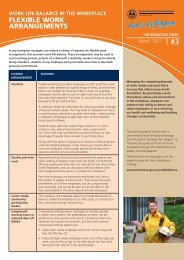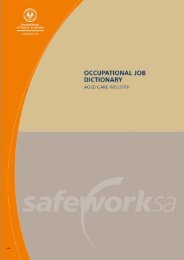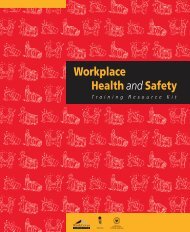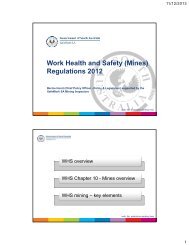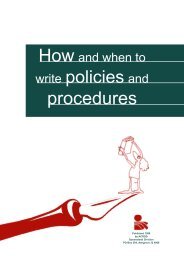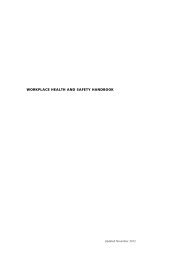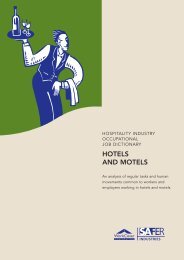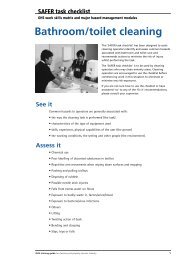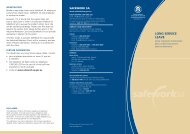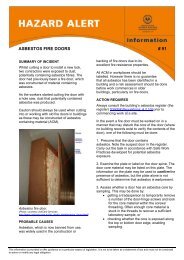Alcohol Drugs Workplace Alcohol Drugs Workplace - SafeWork SA ...
Alcohol Drugs Workplace Alcohol Drugs Workplace - SafeWork SA ...
Alcohol Drugs Workplace Alcohol Drugs Workplace - SafeWork SA ...
Create successful ePaper yourself
Turn your PDF publications into a flip-book with our unique Google optimized e-Paper software.
2<br />
1. INTRODUCTION<br />
A range of factors, both at the workplace and in our private lives, impact on our ability to<br />
work safely. These factors, as they relate to the workplace, must be dealt with through the<br />
normal procedures for dealing with health and safety issues at the workplace. <strong>Alcohol</strong> and<br />
other drugs may be a factor that affects a person’s ability to work safely.<br />
The use of alcohol and other drugs becomes an occupational health and safety issue if a<br />
person’s ability to exercise judgment, coordination, motor control, concentration and<br />
alertness is affected at the workplace, leading to an increased risk of injury or illness.<br />
Employees affected by alcohol or other drugs may present a hazard in the workplace,<br />
causing injury to themselves and others. Co-workers may also be placed in difficult<br />
situations, expected to cover for unsafe work practices or faced with reporting a fellow<br />
employee.<br />
<strong>Alcohol</strong> and other drugs can cause a range of problems for employers. In some cases, their<br />
use may lead to loss of life, injury, damage to plant or equipment and negative publicity for<br />
the business.<br />
These guidelines have been reproduced by <strong>SafeWork</strong> <strong>SA</strong> (www.safework.sa.gov.au) and<br />
Drug and <strong>Alcohol</strong> Services South Australia (www.dassa.sa.gov.au), courtesy of the<br />
Commission for Occupational Safety and Health, Western Australia<br />
(www.worksafe.wa.gov.au) as an explanatory document on how to satisfy the general duty<br />
of care obligations under the Occupational Health, Safety and Welfare Act 1986.<br />
Employers have a general duty to provide a safe workplace and safe systems of work.<br />
Employees must take reasonable care of their own health and safety and not endanger<br />
others at the workplace. In addition, Section 21 of the South Australian Occupational<br />
Health, Safety and Welfare Act 1986 stipulates that employee responsibilities extend to<br />
ensuring that the employee is not, by the consumption of alcohol or a drug, in such a state<br />
as to endanger the employee’s own health and safety at work or the safety of any other<br />
person at work. The consumption of alcohol and illicit drugs whilst at work is therefore<br />
unacceptable and employees should present themselves for work and remain, while at<br />
work, capable of performing their work duties safely.<br />
This document aims to assist employers, self-employed people and employees to<br />
understand and manage alcohol and other drug issues at the workplace.<br />
A range of strategies to manage alcohol and other drugs in the workplace are discussed in<br />
Section 4 of the guidelines. The strategy adopted must ensure workplace hazards and risks<br />
associated with the use of alcohol and other drugs are eliminated or minimised as far as<br />
practicable. If a policy is adopted as part of this strategy, it should reflect the health and<br />
safety needs of that workplace. Education and information about the ways in which<br />
alcohol and other drugs can affect health and safety should form part of every strategy.<br />
It is important that people at a workplace understand the effect that alcohol and other<br />
drugs may have on a person’s ability to work safely. The effect of a range of substances<br />
including alcohol, cannabis, opiate analgesics, hallucinogens, volatile substances and<br />
stimulants is outlined in Section 5. Prescription and over-the-counter medication may affect<br />
a person’s ability to work safely, as can combining different drugs or mixing drugs with<br />
alcohol.<br />
If further information about these substances and their effects is sought, the agencies<br />
outlined in Section 6 should be contacted. Discussion of nicotine is not included in these<br />
guidelines.<br />
Guidelines for Addressing ALCOHOL & OTHER DRUGS IN THE WORKPLACE



